|
Mountain Bike Rear Suspension How many inches have you got? |
Contains:
Included in this page is a good dose of my own opinion, take it as you will, my opinions are based on fact and experience. Being an engineer doesn't hurt either.
Suspension is anything which holds you off the ground, when you ride a bike everything between the tyres and the seat will influence how you feel about the ground that passes under you. But here we're worried about the system in the middle that is designed to absorb the impacts inherent in mountainbiking while also keeping you in control, pedalling effectively and most importantly; enjoying the ride.
A good suspension system allows more comfort (less of a beating), more control (keeping your wheels on the ground) and more fun (you can ride faster, further and longer).
Even a terrible suspension system can do any two of those.
Any form of suspension will increase both comfort and traction. But the difference between good and bad suspension is how it feels, how well it works and how it affects your pedalling efficiency.
In a typical mountainbike suspension system you have the frame split into two main parts. The front section and the rear swingarm or linkage, between the two is the rear shock which usually contains a spring and damper.
The linkage or swingarm controls where the suspension can move, the springs control how much force it takes to move (how stiff it is) and the damper controls how fast it can move in each direction.
The spring in most rear shocks is either compressed air or a metal coil (steel or titanium).
The dampers job is to control the speed in each direction and it does this by forcing air or oil through small holes. The forks and even rear shocks on cheap bikes (especially department store type) are undamped. This makes them a lot springier and can make high speeds quite exciting.
Commonly air forks and shocks are used for their lighter weight in cross country (xc) bikes. Coil spring shocks are more robust and reliable, they are used in situations where performance is more important than the weight difference, usually jumping, dropping, trail-riding and downhill (DH) riding and racing. However with advances in technology the traditional boundaries are becoming blurred.
Air shocks are referred to as progressive or rising rate, meaning they start out softer and get stiffer toward the end than a normal coil spring would. There are exceptions though, all coil springs have a slight progressive nature and can be wound to become very progressive by using coils wound closer together at one end or using tapered wire.
Almost almost any suspension design can be made to absorb bumps well. This depends more on available travel, spring and damper tuning than overall design.
The biggest differences can be found in how each design reacts to pedalling, braking and acceleration forces.
(Climbing forces are the same as acceleration).
I have ranked the designs from best to worst.
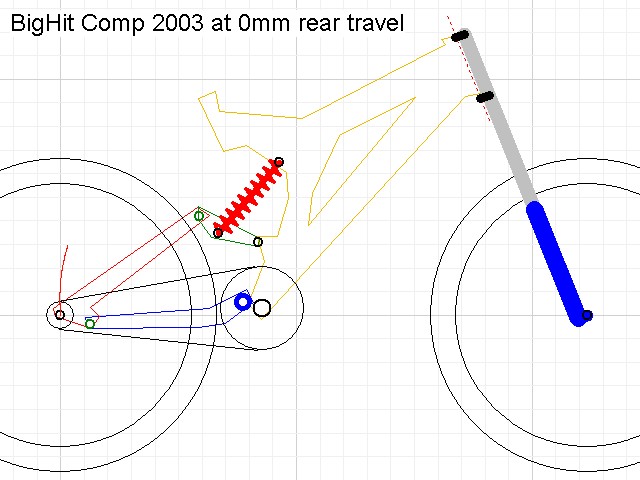
A true four bar bike has the rear axle mounted on a floating rear link. Various designs fit into this category including macpherson struts (older AMP type etc), horst (Specialized FSR) links, VPP (Outland, Schwinn, new Intense) and the lawwill designs (schwinn Straight 8). In the last few years there have been many more true four bars entering mainstream. Giant have their Maestro bikes (Trance, Reign, Anthem etc) and Iron horse has popularised the design originally by Schwinn on the their rocket 88.
Mounting the axle on the rear floating link means the axle doesn't pivot about either of the frame pivots. A clever designer can use this behaviour to produce a system which bobs less, offers better braking traction while climbing and accelerating better than a single pivot can.
Of course being a true four bar doesn't guarantee good performance, geometry, sizing and bike setup have a massive influence.
To learn more about the how and why of four bars, head to the Pedalling Effect and Brake Effect Pages
Of all the four bar designs, I consider the Horst Link (FSR link) to be the best. My current ride of choice is a horst link Turner. In fact the original 5-spot prototype built in 2003.
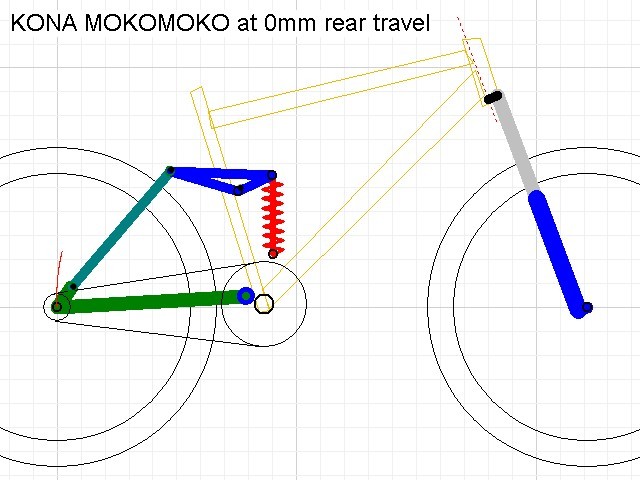
Seatstay pivot bikes have the rear axle mounted to the main frame by a single link (swingarm). All the other links in the rear suspension serve to add a little more lateral stiffness and to drive the shock. Functionally a seatstay pivot bike is a monopivot and the axle path is a perfect arc about the main pivot.
Good examples are Kona, Turners TNT bikes, Ventana, recent Jamis and Transition.
Seatstay pivot bikes perform exactly like similarly placed monopivots under acceleration and chain forces. This means they aren't as neutral under acceleration as horst link bikes but when the brakes are mounted on the seatstays do have an advantage while braking over rough ground.
Specialized currently own the FSR patent and license the design to other makers of Horst Link bikes.
How Ellsworth manage to avoid this is a mystery, functionally their designs are horst links.
Seatstay pivot bikes are often call "Faux Bar" suspension. In general they do not pedal, climb, accelerate or brake as well as a Horst Link four bar.
However the seatstay pivot design is a royalty free zone. This fact alone has bought many makers into the fold. Even including long time Horst-Link manufacturers like Turner.
More of that on the Brake Effect page.
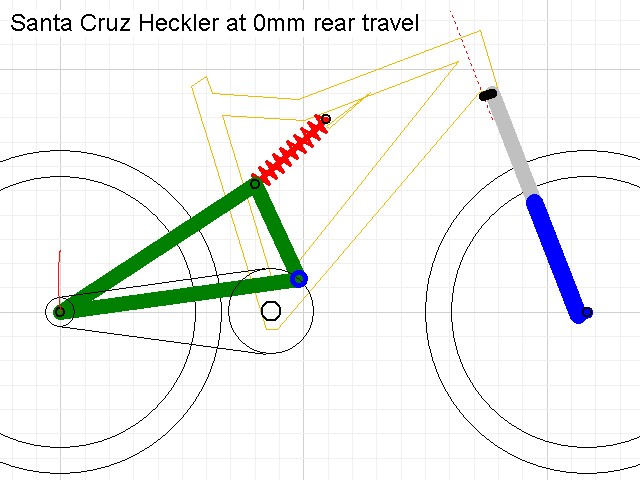
Monopivot designs have one large link (swingarm) connecting the rear axle to the main pivot. There are many variations out there, including internal gearbox and jackshaft driven designs. The axle path is again a perfect arc about the main pivot, they react to bump force, acceleration and chain tension in exactly the same way as a seatstay pivot 4 bar linkage bike does.
Good examples of monopivots are Santa Cruz's Heckler and Bullit.
Monopivot bikes cannot be as neutral under acceleration as a horst link bike and still pedal well.
The other problem with monopivot designs is structural.
All the forces encountered in the rear suspension must be handled by one pivot. Traditionally these pivots are large to handle the forces but the swingarm must also be built stronger and heavier to avoid failure or excessive flex which will wear out the shock. As such monopivots are often heavier than 4 bar linkage bikes.
For downhill riding with a single front chainring I believe excellent performance can be realised from a well designed monopivot with a floating disc brake caliper.
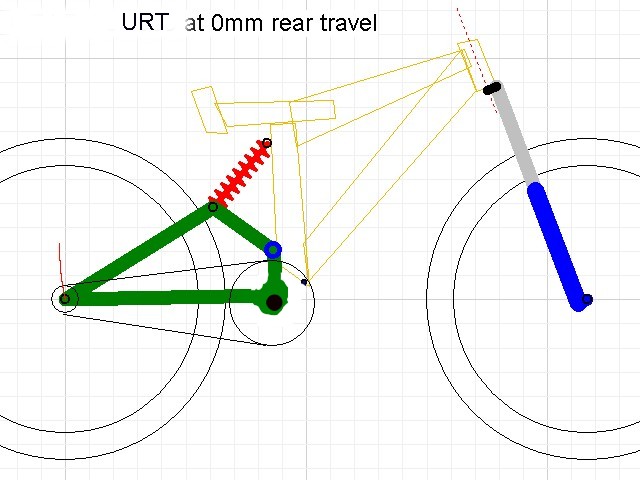
URT's have the BB (and hence the pedals) mounted on the swingarm. The idea of this is that when you stand you shift your weight from a high leverage position (the seat) to a low leverage position (the pedals) on the suspension so it stiffens up when you apply power.
In reality though most bob badly under pedal forces and acceleration and offer a degree of movement between the seat and pedals.
Trying to remove bob on a URT brings about a set of compromises. Efficiency or bump absorbtion, your heart and lungs or your knees.
While URT's are essentially a part of history, there are many designs currently using modified URT designs. GT's I-drive and Mavericks bike are current examples. I don't particularly like the designs or the moving pedals and don't recommend them.
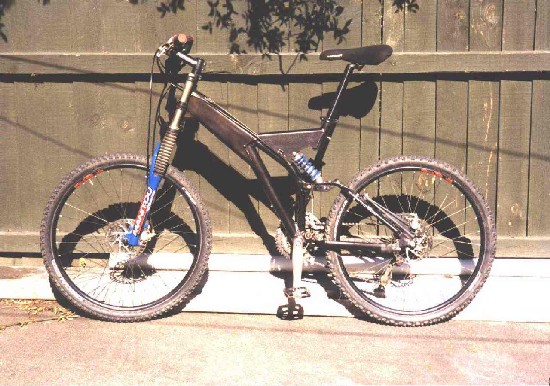
One of my previous toys, 14kg of aluminium, rubber and oil. (2000 Specialized Bighit)
4 bar horst link design with 5 inches of travel and hayes hydraulic disc brakes.